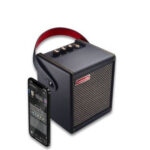Changing your electric guitar strings might seem like a minor detail, easily overlooked by even seasoned guitarists. Many of us find a brand and gauge we like and stick with it for years, even decades. However, sticking to the same old strings could be holding you back. A fresh set of the Best Electric Guitar Strings can dramatically revitalize your instrument, enhancing playability, tone, and overall inspiration.
With a vast array of electric guitar strings available today, venturing beyond your comfort zone can feel overwhelming. To simplify your search, we’ve curated a guide to the top electric guitar strings, categorized by their ideal use cases. Whether you’re seeking the longevity of the best coated electric guitar strings like Elixir Optiweb, or the reliable performance of industry standards like Ernie Ball Slinkys, you’ll discover the perfect strings to match your needs right here.
To further assist you, we’ve included a comprehensive guide on how to choose the right strings for your playing style and preferences. For even more in-depth knowledge, our FAQ section addresses common questions and provides expert advice on all things guitar strings.
Product Guide
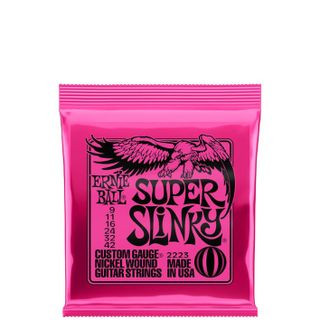 A set of Ernie Ball Super Slinky electric guitar strings
A set of Ernie Ball Super Slinky electric guitar strings
Best overall
- Ernie Ball Slinky
Materials: Nickel-plated
Coating: No
Pros:
- Tried and tested reliability
- Durable construction
- Excellent, versatile sound
Cons:
- Uncoated strings might not last as long as coated options for some players
Ernie Ball Slinky sets have earned their reputation as some of the best-selling electric guitar and bass strings worldwide for good reason. These nickel-plated strings strike an ideal balance of performance, durability, sonic quality, and affordability, making them a fantastic all-around choice for countless guitarists.
The Slinky range is impressively diverse, offering 17 different gauges from the super light 8-38 Extra Slinky to the heavy 12-62 Mammoth Slinky. They even cater to baritone guitars. Ernie Ball has also introduced ‘half’ gauges like the 10.5-52 Mondo Slinky, ensuring there’s a Slinky set to perfectly complement any playing style and tuning preference.
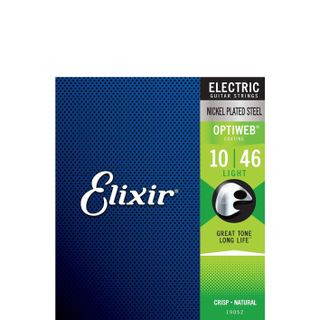 A pack of Elixir Optiweb-coated electric guitar strings
A pack of Elixir Optiweb-coated electric guitar strings
Best coated
- Elixir Optiweb
Materials: Nickel-plated steel-wrapped wire
Coating: Optiweb
Pros:
- Exceptionally long-lasting
- Coating preserves natural string tone
- Bright and resonant sound
Cons:
- Coated feel might not be preferred by all players
Elixir strings are renowned for their innovative approach to string longevity through specialized coatings. Their patented Optiweb coating is designed to extend string life, addressing the common issue of tone degradation over time. While some guitarists worry that coated strings might compromise the natural resonance, Elixir has largely overcome this concern.
Our testing revealed that Elixir Optiweb strings maintain a bright and resonant tone, comparable to uncoated strings, while demonstrably lasting longer. While we still recommend regular string changes for optimal performance, Elixir Optiwebs offer extended freshness, making them a great choice for players who want to minimize string changes without sacrificing tone.
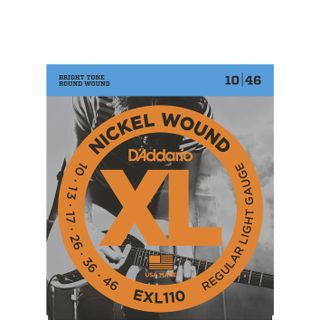 A pack of D
A pack of D
Best beginner
- D’Addario XL
Materials: Nickel-wound
Coating: No
Pros:
- Extensive range of materials and constructions
- Wide selection of gauges
- Highly popular and trusted by players of all levels
Cons:
- Overwhelming variety might be confusing for beginners
The D’Addario XL series is celebrated for its comprehensive range and consistent quality, making it an excellent starting point for players exploring different string types. The XL family encompasses six distinct construction styles, each offering unique tonal characteristics and playing experiences. From the smooth, low-end focused XL Chromes flatwounds to the bright and high-output XL Prosteels, the XL range caters to diverse preferences.
For our evaluation, we focused on the XL Nickel Wound strings, D’Addario’s flagship set. We found them to deliver a balanced and versatile tone, characterized by a pleasing blend of brightness, punch, and warm low-end response. They are not overly bright nor too dark, making them adaptable to various musical genres and playing styles, ideal for beginners discovering their sound.
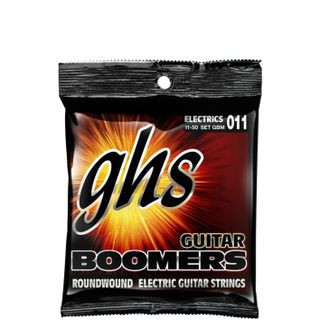 A pack of GHS Boomers electric guitar strings
A pack of GHS Boomers electric guitar strings
Best value
- GHS Boomers
Materials: Roundwound nickel-plated steel
Coating: No
Pros:
- Bright and articulate tone
- Nickel-plated steel construction for balanced sound
- Excellent value for money
Cons:
- Limited gauge selection compared to some brands
- Brightness might be too much for some players or guitars
GHS Boomers are renowned for delivering a bright and punchy tone at an accessible price point. These strings are constructed with nickel-plated steel wrapped around a round steel core. While pure nickel was historically used, nickel-plated steel became the industry standard for its enhanced balance of brightness and warmth.
Boomers provide the essential qualities players seek in electric guitar strings without breaking the bank. While the gauge selection is not as extensive as some other brands, the available options are well-suited for a wide range of musical styles. However, players seeking a warmer, more mellow tone might find Boomers a bit too bright, so considering your desired tonal outcome is key.
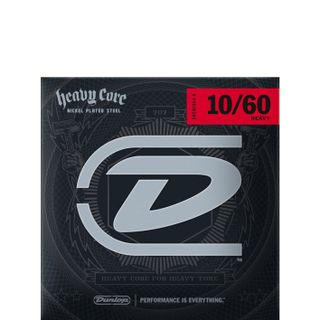 A pack of Dunlop Heavy Core electric guitar strings
A pack of Dunlop Heavy Core electric guitar strings
Best for metal
- Dunlop Heavy Core
Materials: Nickel-plated steel
Coating: No
Pros:
- Optimized for heavy styles and down-tuning
- Maintains clarity and prevents muddiness in low tunings
- Durable and robust construction
Cons:
- Not ideal for players who prefer lighter gauges or brighter tones
Guitarists who frequently play in dropped tunings or favor heavier genres often encounter issues with muddy tone and floppy strings. Dunlop Heavy Core strings are engineered to address these challenges. They feature a modified winding ratio that provides enhanced stability and prevents tone degradation when tuning down.
In our tests, Heavy Core strings delivered a focused low end, clear mids, and increased durability for aggressive playing techniques like palm muting. These strings excel in down-tuned settings, maintaining clarity and punch where standard strings can become indistinct, making them a top choice for metal and heavy rock genres.
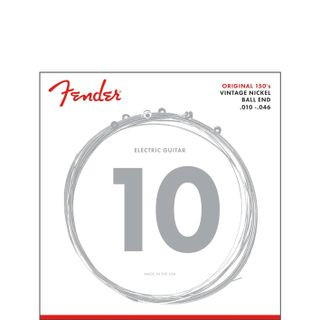 A pack of Fender Pure Nickel electric guitar strings
A pack of Fender Pure Nickel electric guitar strings
Best for Strat
- Fender Pure Nickel
Materials: Pure nickel core, wrapped with nickel wire
Coating: No
Pros:
- Authentic vintage tone
- Reduced finger squeak for smoother playing
- Ideal for blues and classic rock styles
Cons:
- Not suitable for players seeking modern, high-output tones
For Stratocaster enthusiasts and players seeking vintage-inspired tones, Fender Pure Nickel strings are a perfect match. These strings feature a pure nickel core and wrap wire, delivering a warm, mellow tone characteristic of classic guitars from the past. An added benefit of pure nickel is reduced finger noise, resulting in cleaner and smoother playing, particularly when sliding and shifting positions.
Our testing revealed that Pure Nickel strings bring out a sweet brightness that complements single-coil pickups beautifully. While not designed for high-gain metal, they excel in blues, rock, and other genres where vintage warmth and clarity are desired. The strings feel smooth and comfortable right out of the pack, allowing the inherent tone of your guitar to shine through.
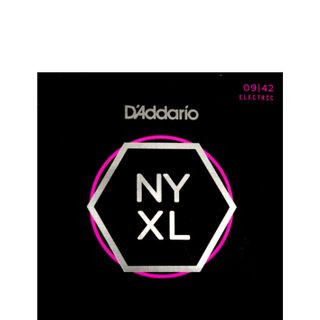 A pack of D
A pack of D
Best for bends
- D’Addario NYXL
Materials: Nickel-plated
Coating: No
Pros:
- Exceptional tuning stability, even with aggressive whammy bar use
- High break resistance for confident bending
- Wide range of gauges available
Cons:
- More expensive than standard uncoated strings
D’Addario NYXL strings are engineered for strength and stability, making them a top choice for players who demand reliable performance under demanding playing conditions, including heavy whammy bar use and aggressive string bending. They utilize a high-carbon steel core combined with nickel-plating for enhanced durability and tuning stability.
D’Addario emphasizes the tuning stability of NYXLs, and our tests confirmed their exceptional performance in this area. The advanced construction and materials result in strings that hold their tuning remarkably well, even under strenuous use. With nearly 20 different gauges available, the NYXL range offers a set for virtually every player who values stability and resilience, despite the slightly higher price point compared to standard strings.
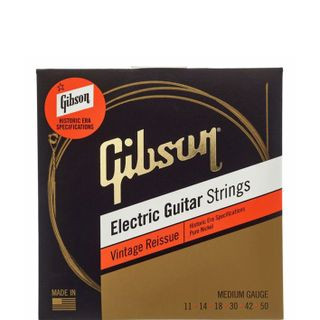 A pack of Gibson Vintage Reissue electric guitar strings
A pack of Gibson Vintage Reissue electric guitar strings
Best for blues
- Gibson Vintage Reissue
Materials: Pure nickel
Coating: No
Pros:
- 100% pure nickel construction for authentic vintage tone
- Warm, clear, and articulate sound
- Excellent for string bending and expressive playing
Cons:
- Warm tone might be too mellow for some musical styles
Gibson Vintage Reissue strings continue the pure nickel theme, offering a distinctly warm and vintage-flavored tone. Made from 100% pure nickel, these strings deliver a mellow yet clear sound that is particularly well-suited for blues and classic rock. The pure nickel composition also contributes to a softer feel, making string bending easier and more comfortable.
During our testing, we found that Vintage Reissue strings naturally leaned towards the bridge pickup due to their inherent warmth. Gibson offers variations within this line, including nickel-plated Brite Wires and Les Paul-specific strings, but the Vintage Reissue set stands out for its focused vintage tone, ideal for blues players seeking authentic sound and feel.
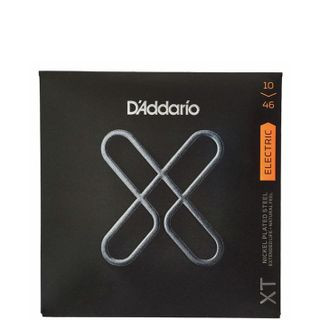 A pack of D’Addario XT electric guitar strings
A pack of D’Addario XT electric guitar strings
Best durability
- D’Addario XT
Materials: High-carbon steel core, nickel-plated steel
Coating: Yes
Pros:
- D’Addario’s premium, most advanced string range
- Coating on all six strings for comprehensive protection
- Excellent balance of feel, tone, and longevity
Cons:
- Coating might feel slightly slick to some players
D’Addario XT strings represent the pinnacle of D’Addario’s electric string technology, combining features from their popular NYXL series with a thin, advanced coating. Utilizing the high-carbon steel core found in NYXLs and a hydrophobic coating on all six strings, XT strings are designed for maximum longevity and consistent performance.
Our tests confirmed that XT strings maintain a fresh string sound for an extended period. They also demonstrated exceptional break resistance and tuning stability. The coating is remarkably thin, preserving a feel very close to uncoated strings, offering the benefits of both worlds: extended life and natural playability. For players prioritizing durability, tuning stability, and long-lasting tone, D’Addario XTs are a top-tier choice.
How to choose
You can trust Guitar World. Our expert reviewers spend hours testing and comparing guitar products so you can choose the best for you. Find out more about how we test.
Time for a change?
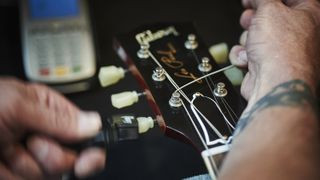 Person using a string winder when fitting a new string on an electric guitar
Person using a string winder when fitting a new string on an electric guitar
(Image credit: Future)
4 signs your strings need replacing
While electric guitar strings are relatively inexpensive compared to major gear purchases like a new acoustic guitar or pedalboard, switching to a fresh set can be a surprisingly impactful way to reignite your playing and break through creative blocks. The subtle changes in feel and tone can inspire new ideas and approaches to your music.
The sheer number of electric guitar string options can be daunting. Different brands, materials, and gauges (thickness) cater to unique playing styles and tonal preferences. Choosing strings is a subjective process, and experimenting with different sets is the best way to discover what works best for you.
When discussing electric guitar strings, Ernie Ball Slinkys are inevitably part of the conversation. Their iconic packaging is instantly recognizable, and their reputation for quality and consistency is well-deserved. Slinkys offer a wide range of gauges and deliver excellent sound, making them a reliable benchmark. The D’Addario EXL series is another highly respected and comparable option, known for its consistent quality and broad appeal.
For players seeking extended string life, Elixir Optiwebs stand out as some of the best coated electric guitar strings available. Their unique coating technology effectively prolongs string freshness and tone. D’Addario XT strings have also made significant advancements in coated string technology, offering coating on all six strings for comprehensive protection and a feel that closely resembles uncoated strings.
FAQs
 Work bench with guitar strings, cutters and string winder
Work bench with guitar strings, cutters and string winder
(Image credit: Future)
What are electric guitar strings made of?
The best electric guitar strings are constructed from a variety of materials, typically featuring a metal core (usually steel) with windings around the lower-pitched strings (E, A, D). Heavier gauge sets might also include a wound G string. Common winding materials include nickel-plated steel, pure nickel, and stainless steel, with other options like cobalt also available.
Nickel-plated strings are the most popular choice due to their balanced and versatile tonal response. Pure nickel strings tend to produce a warmer, mellower tone, while steel strings offer a brighter sound. Nickel-plated steel effectively combines these characteristics, providing a balanced blend of warmth and brightness. Consider your guitar’s pickups when choosing strings – brighter pickups might be complemented by warmer pure nickel strings, for example.
What are the benefits of coated electric guitar strings?
Coated strings have become increasingly prevalent, offering a thin protective layer that shields the strings from dirt, sweat, and corrosion. This coating extends string life and maintains that bright, “new string” sound for longer. While coated strings generally cost more, the extended lifespan can be cost-effective in the long run. Some players initially disliked the feel of early coated strings, but advancements like D’Addario XTs have minimized this difference, creating coated strings that feel nearly identical to uncoated options.
Which string gauge should I use?
String gauge, referring to string thickness, is a crucial consideration when selecting electric guitar strings. Gauge is measured in thousandths of an inch (e.g., 9s or 10s, meaning the high E string is .009 or .010 inches thick). Gauge significantly impacts string feel and playability.
The strings are your primary physical connection to the guitar, making gauge selection highly personal. Players with a heavier touch might prefer heavier gauges to prevent accidentally knocking strings out of tune. Thicker strings also maintain tuning better in lower tunings.
Lighter strings require less effort to move, making bending and vibrato easier. However, some players find lighter strings too easy to bend excessively. Finding the right gauge involves balancing your left and right-hand technique, which may require some experimentation.
There’s no universally “correct” gauge. Beginners often find lighter strings easier to play, while many professionals also prefer them, having adapted their technique to lighter gauges. While some believe thicker strings produce superior tone, prioritizing comfort and playability is generally recommended, as these factors ultimately contribute more to your overall sound and performance.
When should I replace the strings on my electric guitar?
There’s no fixed rule for string replacement frequency. Many players change strings every couple of months. However, frequent players (e.g., 3 hours daily) will wear strings out much faster. Sweat and humidity, especially during live performances, also accelerate string degradation. Many professional guitarists change strings before every gig to ensure optimal tone and reliability.
Regular performers, studio musicians, and those prioritizing peak performance will change strings more frequently. Home players might find monthly changes sufficient. Strings have a limited “sweet spot” of optimal tone and performance. Factors like temperature and humidity fluctuations, sweat, and playing style all contribute to string wear and tonal decline.
To learn more about string changes, refer to our guide on how to restring an electric guitar.
Can you use electric guitar strings on an acoustic?
While electric guitar strings might physically fit on an acoustic guitar, they are not designed to produce a good acoustic tone. Best electric guitar strings are engineered to interact with magnetic pickups, while acoustic strings are designed to resonate and project sound through the guitar’s soundhole. Using electric strings on an acoustic guitar will result in a weak, thin, and uncharacteristic sound.
How we test electric guitar strings
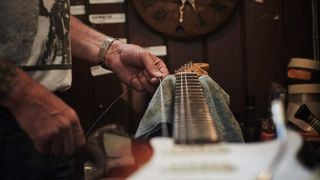 Changing strings on Fender Stratocaster
Changing strings on Fender Stratocaster
(Image credit: Future)
For us at Guitar World, testing electric guitar strings is an enjoyable process centered around playing guitar! We subject strings to real-world playing scenarios to ensure thorough evaluation.
Our testing begins by stringing up a guitar with a fresh set and observing the settling-in period – how quickly the strings stabilize and hold their tuning. Ideally, the best electric guitar strings should achieve tuning stability within minutes, requiring minimal stretching.
Next, we evaluate playability. The best strings should enhance the playing experience, feeling smooth and comfortable, not sticky or rough. For coated strings, we assess whether the coating is noticeable during playing. Longevity is tested by leaving strings on a guitar for an extended period, monitoring when they begin to tarnish and lose their initial brightness and responsiveness.
Finally, and crucially, we assess tone. We play a wide range of musical styles to evaluate how the strings perform across different genres, paying close attention to how the new strings affect the guitar’s overall sonic character.
Read more about our rating system, gear selection process, and detailed testing methodology for all products.

